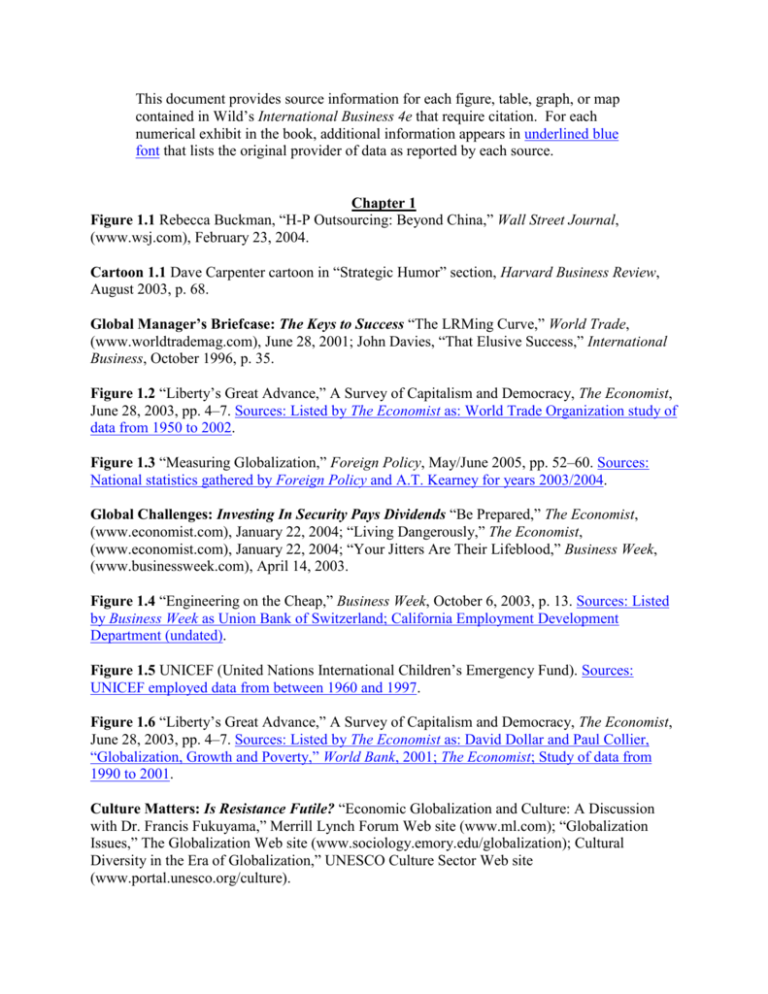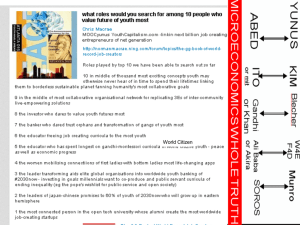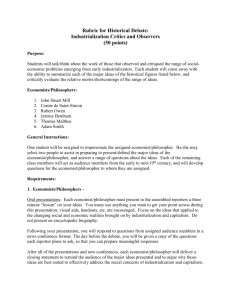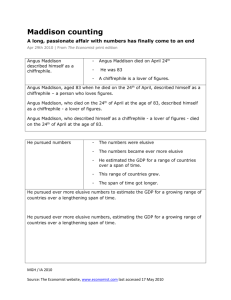
This document provides source information for each figure, table, graph, or map
contained in Wild’s International Business 4e that require citation. For each
numerical exhibit in the book, additional information appears in underlined blue
font that lists the original provider of data as reported by each source.
Chapter 1
Figure 1.1 Rebecca Buckman, “H-P Outsourcing: Beyond China,” Wall Street Journal,
(www.wsj.com), February 23, 2004.
Cartoon 1.1 Dave Carpenter cartoon in “Strategic Humor” section, Harvard Business Review,
August 2003, p. 68.
Global Manager’s Briefcase: The Keys to Success “The LRMing Curve,” World Trade,
(www.worldtrademag.com), June 28, 2001; John Davies, “That Elusive Success,” International
Business, October 1996, p. 35.
Figure 1.2 “Liberty’s Great Advance,” A Survey of Capitalism and Democracy, The Economist,
June 28, 2003, pp. 4–7. Sources: Listed by The Economist as: World Trade Organization study of
data from 1950 to 2002.
Figure 1.3 “Measuring Globalization,” Foreign Policy, May/June 2005, pp. 52–60. Sources:
National statistics gathered by Foreign Policy and A.T. Kearney for years 2003/2004.
Global Challenges: Investing In Security Pays Dividends “Be Prepared,” The Economist,
(www.economist.com), January 22, 2004; “Living Dangerously,” The Economist,
(www.economist.com), January 22, 2004; “Your Jitters Are Their Lifeblood,” Business Week,
(www.businessweek.com), April 14, 2003.
Figure 1.4 “Engineering on the Cheap,” Business Week, October 6, 2003, p. 13. Sources: Listed
by Business Week as Union Bank of Switzerland; California Employment Development
Department (undated).
Figure 1.5 UNICEF (United Nations International Children’s Emergency Fund). Sources:
UNICEF employed data from between 1960 and 1997.
Figure 1.6 “Liberty’s Great Advance,” A Survey of Capitalism and Democracy, The Economist,
June 28, 2003, pp. 4–7. Sources: Listed by The Economist as: David Dollar and Paul Collier,
“Globalization, Growth and Poverty,” World Bank, 2001; The Economist; Study of data from
1990 to 2001.
Culture Matters: Is Resistance Futile? “Economic Globalization and Culture: A Discussion
with Dr. Francis Fukuyama,” Merrill Lynch Forum Web site (www.ml.com); “Globalization
Issues,” The Globalization Web site (www.sociology.emory.edu/globalization); Cultural
Diversity in the Era of Globalization,” UNESCO Culture Sector Web site
(www.portal.unesco.org/culture).
Figure 1.7 Data obtained from “The 2006 Global 500,” Fortune, July 24, 2006, pp. 89–126;
World Development Indicators 2006 (Washington, D.C.: World Bank, April 2006),
(www.worldbank.org). Sources: GDP data came from the World Bank database for 2004;
Revenue data came from the Fortune Global 500 based on 2005 revenue.
Table 1.1 Data obtained from “The 2006 Global 500,” Fortune, July 24, 2006, pp. 89-126.
Sources: Fortune Global 500 based on 2005 revenue.
Entrepreneur’s Toolkit: Four Myths Keeping Small Businesses from Export Success “Is
Business Really Going International?,” Inc., The State of Small Business, 1997, p. 121.
Practicing International Management Case: MTV: Going Global with a Local Beat Peter
Grant, “Coming to Your TV—Homemade Hamster Videos?” Wall Street Journal
(www.wsj.com), November 8, 2006; Marc Gunther, “MTV’s Passage To India,” Fortune
(www.fortune.com), August 9, 2004; Kenny Santana, “MTV Goes to Asia,” Yale Center for the
Study of Globalization, (www.yaleglobal.yale.edu), August 12, 2003; Kerry Capell et al.,
“MTV’s World,” Business Week, February 18, 2002, pp. 81–84; “MTV: 20 Years of
Entertainment Innovation,” CNN, (www.cnn.com), August 2, 2001; “Doug Herzog, Dan Cortese
on MTV’s 20th,” CNN, (www.cnn.com), August 2, 2001.
Chapter 2
Culture Matters: Creating A Global Mindset Phred Dvorak, “Making U.S. Management Ideas
Work Elsewhere,” Wall Street Journal (www.wsj.com), May 22, 2006; “Creating Better
Business Leaders,” Wall Street Journal (www.wsj.com), March 31, 2006; “A Global Spin:
Cultural Adaptability,” Center for Creative Leadership Web site (www.ccl.org), March 2006;
Intercultural Business Center (www.ib-c.com).
Entrepreneur’s Toolkit: Localize Your Web Site Theresa Forsman, “Patience Is an e-Virtue,”
Business Week (www.businessweek.com), July 31, 2001; “Adapting Products and Services for
Global e-Commerce,” World Trade (www.worldtrademag.com), December 20, 2000; Moira
Allen, “Net the World,” Entrepreneur Magazine (www.entrepreneur.com), June 2000.
Global Manager’s Briefcase: A Globetrotter’s Guide to Manners Moira Allen “Talking
Heads,” Entrepreneur Magazine (www.entrepreneur.com), January 2001; Moira Allen “TouchyFeely,” Entrepreneur Magazine (www.entrepreneur.com), September 2000; Moira Allen “Czech
List,” Entrepreneur Magazine (www.entrepreneur.com), July 2000; Tatiana D. Helenius, “Body
Language Savvy,” CNN Web site, (www.cnnfn.com), May 3, 2000.
Map 2.1 Mapping © Bartholomew, 1990. Extract taken from Plate 5 of The Comprehensive
Atlas of the World, 8th ed. Reprinted with permission.
Global Challenges: Speaking in Fewer Tongues Clyde Haberman, “Watch Your Languages.
They’re Ancient,” New York Times (www.nytimes.com), February 24, 2004; Mauro E. Mujica,
“English: Not America’s Language?,” The Globalist (www.theglobalist.com), June 19, 2003;
Steve Connor, “Speaking in Fewer Tongues,” The World in 2001 (London, The Economist
Newspaper Limited, 2000), pp. 142–143; Anthony C. Woodbury, “What Is An Endangered
Language?,” Linguistic Society of America, (www.lsadc.org).
Figure 2.1 Louis E. Boone, David L. Kurtz, and Judy R. Block, Contemporary Business
Communication, 2nd ed. (Upper Saddle River, NJ: Prentice Hall, 1997), p. 71.
Table 2.1 Adapted from World Development Indicators 2006 (Washington, D.C.: World Bank,
April 2006), (www.worldbank.org). Sources: World Bank illiteracy data for 2004.
Figures 2.2 and 2.3 Geert Hofstede, “The Cultural Relativity of Organizational Practices and
Theories,” Journal of International Business Studies, Fall 1983, p. 82, 84.
Practicing International Management Case: Modernization or Westernization? Saritha Rai,
“U.S. Payrolls Change Lives in Bangalore,” New York Times (www.nytimes.com), February 22,
2004; Joanna Slater, “For India’s Youth, New Money Fuels A Revolution,” Wall Street Journal
(www.wsj.com), January 27, 2004; Lara Sowinski, “Southeast Asia Reeling from a One-Two
Punch,” World Trade (www.worldtrademag.com), July 3, 2001.
Chapter 3
Map 3.1 Data obtained from Freedom in The World, 2006 (New York: Freedom House, 2006),
(www.freedomhouse.org). Sources: Freedom House study conducted for calendar year 2005.
Global Challenges: From Civil War to Civil Society “Putting the World to Rights,” The
Economist (www.economist.com), June 3, 2004; “The Price of Peace,” The Economist
(www.economist.com), April 22, 2004; “The Global Menace of Local Strife,” The Economist
(www.economist.com), May 22, 2003; Paul Collier and Anke Hoeffler, The Challenge of
Reducing the Global Incidence of Civil War (Oxford: Copenhagen Consensus, March 2004);
“Coping with Conflict,” The Economist (www.economist.com), January 15, 2004.
Map 3.2 Data obtained from International Country Risk Guide (East Syracuse, NY: PRS Group,
2005), October 2005, (www.countrydata.com). Sources: Political Risk Services country risk
analysis for month of October 2005.
Table 3.1 Adapted from Corruption Perceptions Index 2005 (Berlin: Transparency International,
October 2005), Transparency International Web site (www.transparency.org). Sources:
Transparency International study of data for 2003, 2004, and 2005.
Culture Matters: Playing By The Rules “Japan: Lawyers Wanted. No, Really,” Business Week
(www.businessweek.com), April 3, 2006; Dexter Roberts, “Waking Up to Their Rights,”
Business Week, August 22/29, pp. 123-128; Saudi Arabia country profile on ArabNet Web site
(www.arab.net/saudi); Sjef van Erp, “Law and Culture,” Electronic Journal of Comparative Law
(www.ejcl.org), Vol. 5.1, March 2001.
Figure 3.1 Adapted from Third Annual BSA and IDC Global Software Piracy Study
(Washington, D.C.; Business Software Alliance, May 2006), Table 3, pp. 14-15,
(www.bsa.org/globalstudy). Sources: Business Software Alliance data for 2005.
Entrepreneur’s Toolkit: The Long Arm of The Law Federal Trade Commission Web site,
(www.ftc.gov); U.S. Consumer Product Safety Commission Web site, (www.cpsc.gov); U.S.
Patent and Trademark Office Web site, (www.uspto.gov); U.S. International Trade Commission
Web site, (www.usitc.gov).
Figure 3.2 United Nations Department of Public Information, (www.un.org).
Practicing International Management Case: Caveat Emptor—Who Said Latin Was Dead?
Andrew Batson, “Fox Aims to Foil Piracy in China With Cheap DVDs,” Wall Street Journal
(www.wsj.com), November 13, 2006; “Psst, Wanna Buy a Cheap Bracelet?,” The Economist
(www.economist.com), July 1, 2004; Nick Wingfield, “Tiffany Sues eBay for Allowing
Counterfeit Merchandise on Site,” Wall Street Journal (www.wsj.com), June 22, 2004; Frederik
Balfour, “Armani Is Starting His Long March to China,” Wall Street Journal (www.wsj.com),
May 3, 2004; Murray Hiebert, “Car-Parts Piracy Has Auto Makers Spinning Their Wheels,”
Wall Street Journal (www.wsj.com), February 26, 2004.
Chapter 4
Global Manager’s Briefcase: Guidelines for Good Guanxi Steve Barth, “Bridge over Troubled
(Cultural) Water,” World Trade, August 1997, pp. 32–33; Michele Marchetti, “Selling in China?
Go Slowly,” Sales & Marketing Management, January 1997, pp. 35–36; Charlene Marmer
Solomon, “The Big Question,” Global Workforce, July 1997, pp. 10–16.
Map 4.1 Data obtained from 2006 Index of Economic Freedom, The Heritage Foundation Web
site (www.heritage.org). Sources: Heritage employed multiple sources and several years of data
to develop each variable that is a part of each index—see the following Web site for details of
the methodology behind the latest index:
(http://www.heritage.org/research/features/index/chapters/htm/index2007_chap3.cfm).
Culture Matters: Foundations of Development Manjeet Kripalani, “India: Bridging The
Digital Divide,” Business Week, June 28, 2004, pp. 60–62; Ricardo Hausmann, “Prisoners of
Geography,” Foreign Policy, January/February 2001, pp. 45-53; Lawrence E. Harrison and
Samuel P. Huntington, eds, Culture Matters: How Values Shape Human Progress (New York,
NY: Basic Books, 2000).
Figure 4.2 Data obtained from 2006 Index of Economic Freedom (Washington, D.C.: Heritage
Foundation, 2006), The Heritage Foundation Web site (www.heritage.org). Sources: Heritage
employed data from (among other sources) World Bank’s World Development Indicators 2005;
CIA’s World Factbook 2004; International Monetary Fund (2005 data).
Map 4.2 Data obtained from World Bank, Country Classification section, (www.worldbank.org),
June 2006. Sources: World Bank Gross National Income (GNI) data for 2004/2005.
Table 4.1 Data obtained from Organisation for Cooperation and Development (OECD),
“Statistics” section, (www.oecd.org), May 2006. Sources: GDP per capita data as contained in
National Accounts of OECD Countries, Main Aggregates, Volume 1, for 2004.
Table 4.2 Data obtained from Human Development Report 2005, (New York, NY:
United Nations Development Programme, 2005), (www.undp.org), Table 1, pp. 219–222.
Sources: United Nations employed data from (among other sources) UN agencies, the World
Bank, UNESCO, and UNICEF for years 2002/2003.
Global Challenges: Public Health Goes Global “Twenty-Five Years of AIDS,” The Economist,
June 3, 2006, pp. 24-25; “Preparing for a Pandemic,” Harvard Business Review Special Report,
May 2006, pp. 20-40; “The Cost of AIDS,” The Economist, May 22, 2004, pp. 68 & 71; Gavin
Yamey, “Roll Back Malaria: A Failing Global Health Campaign,” British Medical Journal
(www.bmj.com), May 8, 2004, pp. 1086-1087; Anne Mills and Sam Shillcutt, The Challenges of
Communicable Disease (Oxford: Copenhagen Consensus, February 2004); Malaria Foundation
International (www.malaria.org), various reports.
Practicing International Management Case: Talkin’ Bout A Revolution “Cuba’s Gulag,” The
Economist (www.economist.com), April 1, 2004; “Nickel, but No Dimes,” The Economist
(www.economist.com), September 18, 2003; “The Disaster Is Now ‘Irrevocable,’” The
Economist (www.economist.com), July 4, 2002; Sheridan Prasso, “Think Twice About Havana
Holidays,” Business Week, September 10, 2001; Gail DeGeorge, “A Touch of Capitalism,”
Business Week, March 17, 1997, pp. 50, 52; William C. Symonds and Gail DeGeorge, “Castro’s
Capitalist,” Business Week, March 17, 1997, pp. 48–49.
Chapter 5
Map 5.1 World Development Indicators 2006 (Washington, D.C.: World Bank, April 2006),
(www.worldbank.org). Sources: World Bank data for 2004.
Table 5.1 International Trade Statistics 2005 (Geneva: World Trade Organization, November
2004), Tables I.5 & I.7, (www.wto.org). Sources: World Trade Organization data for 2004.
Table 5.2 International Trade Statistics 2005, (Geneva: World Trade Organization, November
2004), (www.wto.org), Table III.3. Sources: World Trade Organization data for 2004.
Global Manager’s Briefcase: Building Good Relations in the Pacific Rim Bradford W.
Ketchum, Jr., “Five Rules for Building Good Relations in the ‘Rim’ and Beyond,” Inc.,
[Advertising Supplement], May 20, 1997.
Figure 5.4 Raymond Vernon and Louis T. Wells, Jr., The Economic Environment of
International Business, 5e (Upper Saddle River, NJ: Prentice Hall, 1991), p. 85.
Entrepreneur’s Toolkit: Five Common Fulfillment Mistakes Adapted from “Five Common
Fulfillment Mistakes,” World Trade, Global Online supplement, (www.worldtrademag.com),
February 27, 2001.
Figure 5.5 Michael E. Porter, “The Competitive Advantage of Nations,” Harvard Business
Review (March-April 1990), p. 77.
Map 5.2 Harvard Business Review (November-December 1998), p. 82.
Practicing International Management Case: First in Asia and the World “The New DHL
Makes U.S. Debut,” DHL Web site, (www.dhl.com), Press release, February 16, 2004; “DHL
Earns Gold Medal as Third Party Logistics Provider for Second Year in Quest for Quality
Survey,” DHL Web site, (www.dhl.com), Press release, October 2, 2001; Josephine Bow, “The
Fast-Paced World of Asian Express,” Distribution (February 1996), pp. 44–47.
Chapter 6
Entrepreneur’s Toolkit: Experts in Export Financing Export-Import Bank of the United
States Web site (www.exim.gov).
Figure 6.1 World Trade Organization Web site (www.wto.org).
Table 6.2 “About the WTO,” World Trade Organization Web site (www.wto.org).
Practicing International Management Case: Unfair Protection or Valid Defense? “Shrimp
Wars,” The Economist (www.economist.com), July 8, 2004; “China to Begin Probe of Synthetic
Rubber Imports,” Wall Street Journal (www.wsj.com), March 19, 2002; Neil King, Jr. and Geoff
Winestock, “Plan to Rescue U.S. Steel Industry Draws the Ire of Critics Abroad,” Wall Street
Journal (www.wsj.com), March 7, 2002.
Chapter 7
Figure 7.1 World Investment Report 2005 (Geneva, Switzerland: UNCTAD, September 2005),
Chapter 1, Figure I.5, p. 13. Sources: FDI flow data taken from the United Nations Conference
on Trade and Development FDI/TNC database (www.unctad.org/fdistatistics); GDP data taken
from the World Economic Outlook Database, April 2005.
Figure 7.2 World Investment Report 2003 (Geneva, Switzerland: UNCTAD, 2003), Chapter 1,
Figure I.2.2, p. 16. Sources: United Nations Conference on Trade and Development database on
M&As between 1990 and 2002.
Entrepreneur’s Toolkit: Cowboy Candy Rides into Manchuria Adapted from Marcus W.
Brauchli, “Sweet Dreams,” Wall Street Journal, June 27, 1996, R, 10:1.
Global Manager’s Briefcase: Prepare for Surprises When Investing Abroad Adapted from
Jim Schriner, “Be Prepared for Surprises,” Industry Week, December 2, 1996, p. 22.
Table 7.1 World Investment Report 2005 (Geneva, Switzerland: UNCTAD, September 2005),
Overview, Table 5, p. 9. Sources: United Nations Conference on Trade and Development
database on national laws and regulations for 2004.
Table 7.2 Survey of Current Business, July 2001, (Washington, D.C.: U.S. Department of
Commerce, 2001), p. 47. Source: U.S. Bureau of Economic Analysis research and analysis for
year 2000.
Practicing International Management Case: Mercedes-Benz Is Footloose In Tuscaloosa Gail
Edmondson, David Welch, and David Kiley, “Daimler Shakeup: Realignment in the Auto
Industry,” Business Week (www.businessweek.com), January 25, 2006; “Real People, Real
Choices,” #2, Custom Videos for Marketing, Part II. Robert Baxter, Mercedes-Benz of North
America; Justin Martin, “Mercedes: Made in Alabama,” Fortune, July 7, 1997, pp. 150–158; Bill
Vlasic, “In Alabama, the Soul of a New Mercedes?,” Business Week, March 31, 1997, pp. 70–71.
Chapter 8
Entrepreneur’s Toolkit: Czech List Adapted from Moira Allen, “Czech List: Doing Business
with Eastern Europe,” Entrepreneur Magazine, (www.entrepreneur.com), July 2000.
Practicing International Management Case: Tainted Trade Brings Increase in Illness
“Preparing for a Pandemic,” Harvard Business Review Special Report, May 2006, pp. 20-40;
“The Aves, and Ave Nots,” The Economist (www.economist.com), February 23, 2006; Janet
Ginsburg, “Bio Invasion,” Business Week, September 11, 2000, 70–78; Richard A. Ryan, “Mom
Says NAFTA Is A Safety Issue,” Detroit News, September 10, 1997, p. B3.
Chapter 9
Entrepreneur’s Toolkit: Where Microcredit Is Due Adapted from Skip Kaltenheuser,
“Spearing Loan Sharks,” World Trade, May 1997, pp. 32–34.
Tables 9.1 and 9.2 Wall Street Journal (www.wsj.com), May 13, 2004. Source: Listed by the
Wall Street Journal as based on trading among banks of $1 million and more as quoted daily at 4
p.m. ET by Reuters.
Global Manager’s Briefcase: Five Strategies for More Effective Foreign Exchange
Management Adapted from David Spiselman, Five Strategies for Saving Money and Improving
Control over Foreign Exchange (San Mateo, CA: Sonnet Financial Inc., 1995), pp. 8–10.
Practicing International Management Case: Is Argentina Back From The Abyss? “Argentina
Tops Household Consumption in Latin America,” The Economist (www.economist.com), June
29, 2006; “Country Risk” The Economist (www.economist.com), June 29, 2006; “Pickets and
Police,” The Economist (www.economist.com), July 1, 2004; Sonja Ryst, “Argentine Utilities
Squeezed Amid Rate Fix, Peso Slide,” Wall Street Journal (www.wsj.com), March 26, 2002;
Pamela Druckerman, “Argentine Crisis Deepens As Peso Falls to New Lows,” Wall Street
Journal (www.wsj.com), March 26, 2002; Pamela Druckerman and Matt Moffett, “With IMF in
Mind, Argentina Switches Dollar Debt to Pesos,” Wall Street Journal (www.wsj.com), March
15, 2002.
Chapter 10
Figures 10.1 & 10.2 Economic Report of the President, Table B110, multiple years. Sources:
Certified non-buying rates in New York (Figure 10.1) and trade-weighted value of the U.S.
dollar (Figure 10.2) between 1970 and 2005 as reported by the Board of Governors of the
Federal Reserve System.
Global Manager’s Briefcase: Exporting Against the Odds Louis Uchitelle, “Reconsidering a
Trade Equation,” New York Times, October 31, 1997, pp. D1, D2.
Figure 10.3 “Big Mac Index,” The Economist (www.economist.com), January 12, 2006.
Sources: The Economist using McDonald’s pricing data (undated).
Figure 10.4 Data obtained from IMF Annual Report, 2001 (Washington, DC: International
Monetary Fund, 2001), Table 6.5, p. 68.
Practicing International Management Case: Banking On Forgiveness “US, Europe Debating
Grants Vs. Loans For Debt Relief,” Wall Street Journal (www.wsj.com), March 19, 2002;
Richard W. Stevenson, “Global Banks Offer a First: Forgiveness on Some Debt,” New York
Times, March 12, 1997, p A5; “Debt Relief for Model Countries,” New York Times, May 1,
1997, p. A26; World Bank, (www.worldbank.org), various reports on the HIPC Debt Initiative.
Chapter 11
Figure 11.2 Michael E. Porter, On Competition (Boston: Harvard Business School Press, 1998),
p. 77.
Entrepreneur’s Toolkit: Know Yourself, Know Your Product Adapted from Davis P.
Goodman, “The First Pillar: Assess Your Capabilities,” World Trade, March 1999, pp. 48–53.
Figure 11.4 Michael E. Porter, Competitive Strategy (New York: Free Press, 1980), p. 39.
Global Manager’s Briefcase: Competing With Giants Adapted from Niraj Dawar and Tony
Frost, “Competing with Giants: Survival Strategies for Local Companies in Emerging Markets,”
Harvard Business Review, March–April 1999, pp. 119–129.
Practicing International Management Case: The Global Strategy of IKEA Kerry Capell,
“Ikea’s New Plan for Japan,” Business Week (www.businessweek.com), April 26, 2006; “Ikea
To Spend GBP50M Extending UK Stores,” Wall Street Journal (www.wsj.com), January 11,
2002; “Ikea To Expand In Southern Europe,” Wall Street Journal (www.wsj.com), December
18, 2001; Ikea Web site (www.ikea.com), selected reports.
Chapter 12
Map 12.1 World Development Indicators 2006 (Washington, DC: World Bank, April 2006),
(www.worldbank.org). Sources: World Bank data for 2004.
Figure 12.2 Site Selection, December 1997/January 1998, p. 1122.
Figure 12.3 Graphic obtained from Market: Newsletters Company.
Practicing International Management Case: Vietnam’s Emerging Market Potential “Good
Morning at Last,” The Economist, August 5, 2006, pp. 37–38; “Vietnam’s Export Worth $22.3
Billion,” Vietnam Ministry of Trade press release, July 25, 2006; “Scandal In Vietnam,” The
Economist (www.economist.com), April 27, 2006; “The Good Pupil,” The Economist
(www.economist.com), May 6, 2004.
Chapter 13
Figure 13.1 International Trade Statistics 2005 (Geneva, Switzerland: World Trade
Organization, October 2005), Table III.16, p. 51. Sources: World Trade Organization data for
2004.
Entrepreneur’s Toolkit: Global Collection Guidelines Adapted from James Welsh, “Covering
Your Bets on Credit and Collections,” World Trade, February 1999, pp. 28–29.
Figure 13.5 Peter Buckley and Mark Casson, “A Theory of Cooperation in International
Business,” in Farok J. Contractor and Peter Lorange (eds.), Cooperative Strategies in
International Business (Lexington, MA: Lexington Books, 1988) pp. 31–53.
Global Manager’s Briefcase: Negotiating the Terms of Market Entry Andrew C. Inkpen and
Paul W. Beamish, “Knowledge, Bargaining Power, and the Instability of International Joint
Ventures,” Academy of Management Review, 22:1, pp. 177–202; Arvind V. Phatak and
Mohammed M. Habib, “The Dynamics of International Business Negotiations,” Business
Horizons, May–June 1996, pp. 30–38; David K. Tse, June Francis, and Jan Walls, “Cultural
Differences in Conducting Intra- and Inter-Cultural Negotiations: A Sino-Canadian
Comparison,” Journal of International Business Studies, 25:3, pp. 537–555.
Figure 13.6 Franklin R. Root, Entry Strategies for International Markets (Lexington, MA:
Lexington Books, 1987), pp. 8–21.
Practicing International Management Case: Telecom Ventures Unite the World Barbara
Martinez, “Sprint Names Its Long-distance Chief to Run Loss-Beset Global One Venture,” Wall
Street Journal, February 17, 1998, p. B20; Jennifer L. Schenker and James Pressley, “European
Telecom Venture with Sprint Hasn’t Become the Bully Some Feared,” Wall Street Journal,
December 23, 1997, p. A11; Alan Cane, “Unisource Partners to Strengthen Ties,” Financial
Times, June 4, 1997, p. 13; Gautam Naik, “Unisource Expected to Merge Operations,” Wall
Street Journal, June 4, 1997, p. B6.
Chapter 14
Global Manager’s Briefcase: Managing an International Sales Force Adapted from Charlene
Marmer Solomon, “Managing An Overseas Sales Force,” World Trade, Global Sales and
Technology Special Section, pp. S4–S6.
Figure 14.1 Adapted from Courtland L. Bovee, John V. Thill, George P. Dovel, and Marian
Burk Wood, Advertising Excellence (New York, NY: McGraw-Hill, 1995), p. 14.
Practicing International Management Case: Fair Game or Out-of-Bounds? Ellen Neuborne,
“For Kids on the Web, It’s an Ad, Ad, Ad, Ad World,” Business Week,
(www.businessweek.com), August 13, 2001; Brandon Mitchener, “Banning Ads on Kids’ TV,”
Wall Street Journal Europe, May 22, 2001, p. 25; James MacKinnon, “Psychologists Act against
Ad Doctors,” Adbusters Web site, (www.adbusters.org).
Chapter 15
Figure 15.1 Adapted from “Wages,” The Economist, December 8, 2001, p. 106. Sources: Listed
by The Economist as William M. Mercer (undated).
Global Manager’s Briefcase: Linking TQM and ISO 9000 Standards Adapted from G.K.
Kanji, An Innovative Approach to Make ISO 9000 Standards More Effective.” Total Quality
Management, February 1998, pp. 67–79.
Entrepreneur’s Toolkit: Overseas Investors Offer Global Cash Adapted from Jenny C.
McCune, “Get Global Cash,” Success, December 1995, p. 16.
Practicing International Management Case: Toyota’s Strategy for Production Efficiency
“Q&A: Pushing Carmakers to Rev Up Factories,” Business Week, (www.businessweek.com),
February 18, 2002; William Greider, One World, Ready or Not: The Manic Logic of Global
Capitalism, (New York, NY: Simon & Schuster, 1997), Chapter 6 “Jikoda”; Micheline Maynard,
“Camry Assembly Line Delivers New Minivan,” USA Today, August 11, 1997, p. 3B.
Chapter 16
Figure 16.1 Prices and Earnings: 2005 Update (Zurich, Switzerland: Union Bank of
Switzerland, 2005), (www.ubs.com) p. 7. Sources: Union Bank of Switzerland internal research
and analysis of data for 2004.
Entrepreneur’s Toolkit: Growing Global Laurel Delaney, “Is It Time To Go Global?,”
Entrepreneur Magazine (www.entrepreneur.com), April 04, 2001; Ysabel de la Rosa, “In
Country,” Entrepreneur Magazine (www.entrepreneur.com), March 2001; Charlotte Mulhern,
“Going The Distance,” Entrepreneur Magazine (www.entrepreneur.com), May 1998.
Global Manager’s Briefcase: A Shocking Ordeal Gary P. Ferraro, The Cultural Dimensions of
International Business, 5th ed. (Upper Saddle River, NJ: Pearson Prentice Hall, 2006), pp. 151–
165; David Stamps, “Welcome to America: Watch out for Culture Shock,” Training, November
1996, pp. 22–30; John R. Engen, “Coming Home,” Training, March 1995, pp. 37–40; Adrian
Furnham and Stephen Bochner, Culture Shock (London: Methuen, 1986); J.T. Gullahorn and J.E.
Gullahorn, “An Extension of the U-Curve Hypothesis,” Journal of Social Sciences, January
1963, pp. 34–47; Kalvero Oberg, “Culture Shock: Adjustments to New Cultural Environments,”
Practical Anthropology, July–August 1960, pp. 177–182. Box Figure from Stephen P. Robbins,
Organizational Behavior: Concept, Controversies, Applications, 7th ed. (Upper Saddle River,
NJ: Prentice Hall, 1996), p. 60.
Figure 16.3 “Long Time No Work,” Wall Street Journal Europe, August 28, 2001, p. 15.
Practicing International Management Case: Expatriation or Discrimination? “Staffing
Globalization,” The Economist (www.economist.com), June 24, 2006, pp. 77–80; James
Harding, “When Expats Should Pack Their Bags,” Financial Times, September 1, 1998, p. 10;
C.K. Prahalad and Kenneth Lieberthal, “The End of Corporate Imperialism,” Harvard Business
Review, July–August 1998 pp. 68–79.





